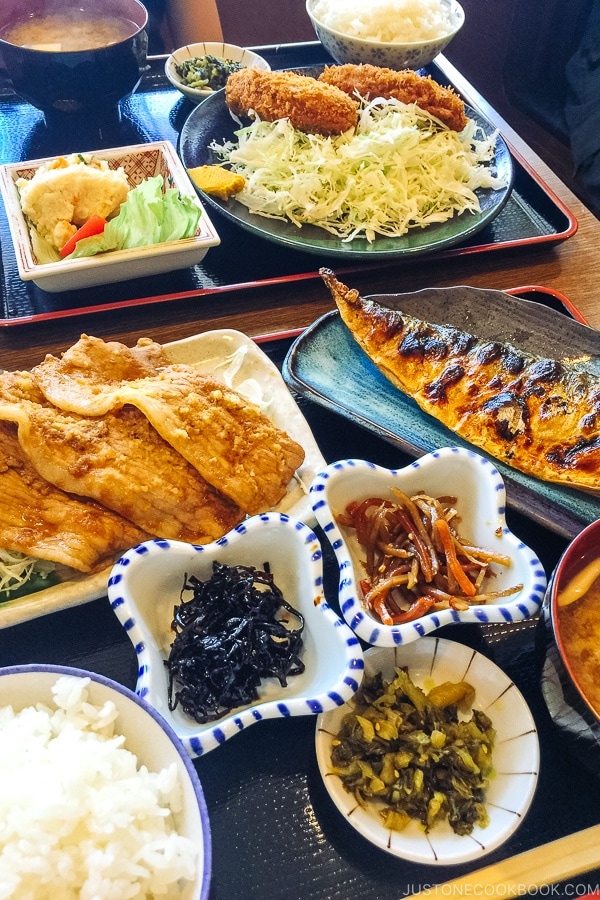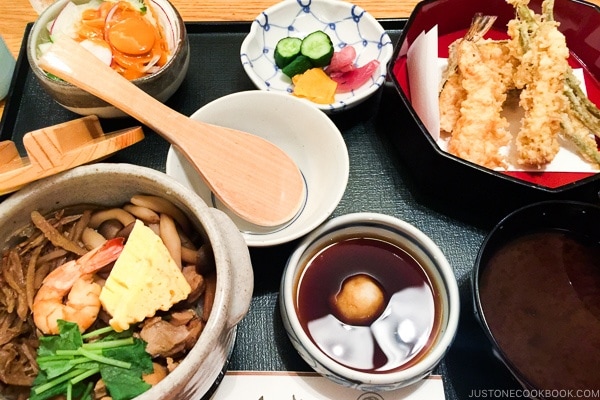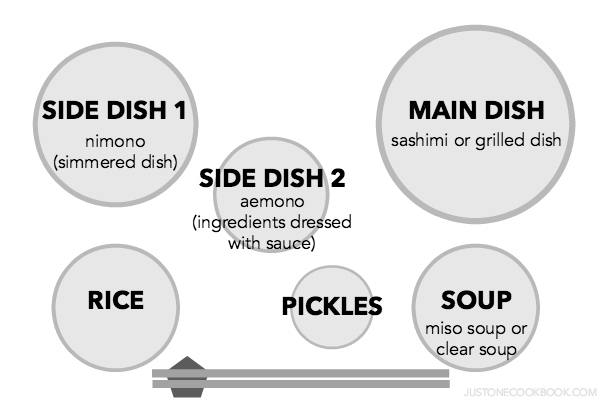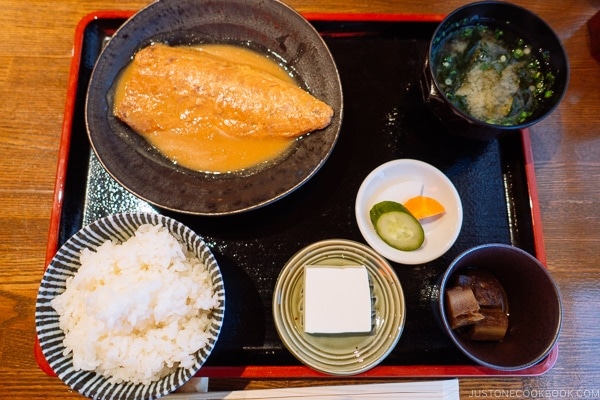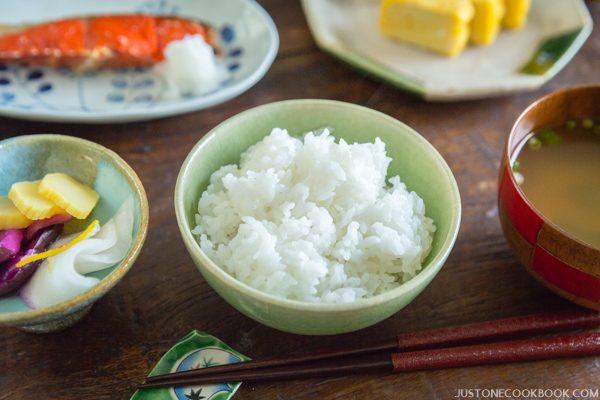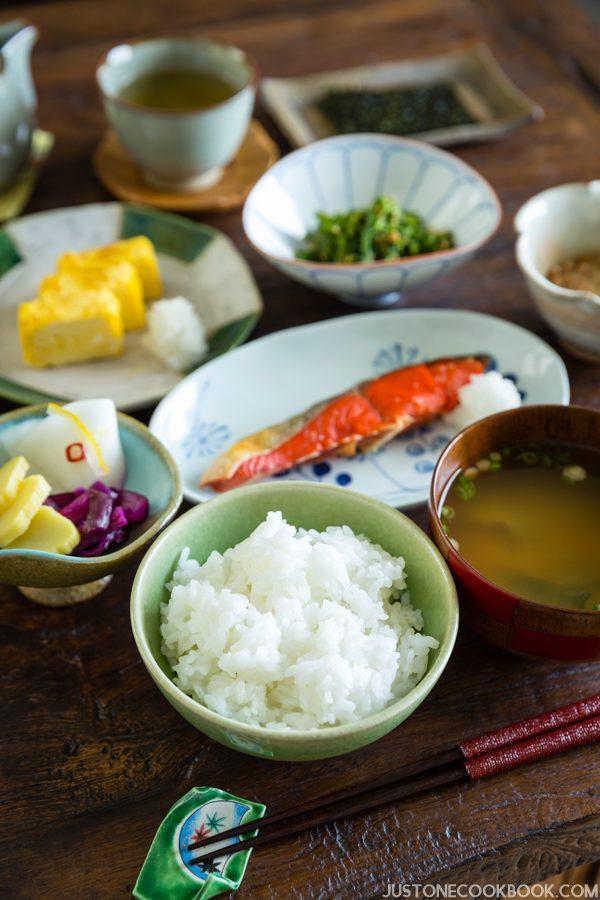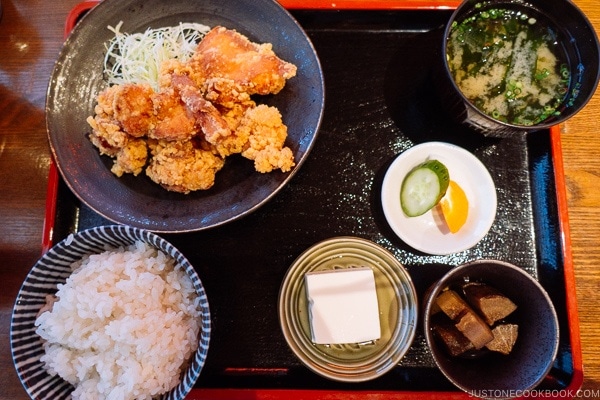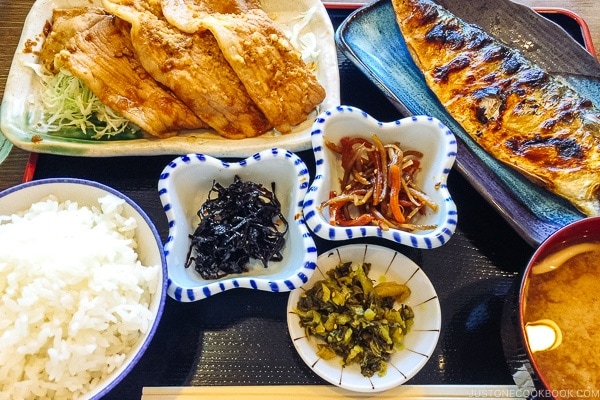Thanks to Japanese food porn shows such as Midnight Diner: Tokyo Stories (Shinya Shokudo 深夜食堂), The Solitary Gourmet (Kodoku no Gourmet 孤独のグルメ), Samurai Gourmet (Nobushi no Gourmet 野武士のグルメ) and The Makanai: Cooking for the Maiko House (Maikosanchi no Makanaisan 舞妓さんちのまかないさん), we receive many questions from curious readers about the dishes featured on the shows (Nami has an entire section of recipes on Midnight Diner Recipe Series and The Makanai). But most interesting were the questions like “What do the Japanese eat every day?” and “How can I plan and cook Japanese food at home?” Contrary to popular belief, the Japanese do not live off a steady diet of ramen, sushi, and tempura (although I wish!) Japanese cuisine, or Washoku, is simple and has a nutritious balance of protein, fiber, and vegetables portioned in plates and bowls. Called Ichiju Sansai (一汁三菜), literally “one soup three dishes,” this is the foundation of a Japanese meal.
What is Ichiju Sansai
A typical Japanese meal comprises four elements: rice, soup, side dishes, and pickled vegetables.
Gohan (ご飯) – a bowl of plain steamed rice Shiru (汁) – a bowl of soup, which may contain vegetables or tofu Okazu (おかず) – main dish and two side dishes composed of vegetables, tofu, fish, or meat Kouno mono(香の物) – a small plate of Tsukemono, pickled vegetables
This meal format can be served for breakfast, lunch, or dinner. If you’ve been fortunate to spend a night at a ryokan (Japanese inn), you may have witnessed the elaborate spread of dishes for breakfast. Or perhaps you may have encountered something similar in the form of a teishoku (set menu) at Ootoya Restaurant (the Japanese chain restaurant) or other places. Each dish is served as a light portion and is intended to not only fill you up but to also obtain the necessary minerals and vitamins to keep you charged throughout the day.
Origin Story
The style of “one soup three dishes” originates from Honzen Ryori (本膳料理), a highly refined system of meal-serving that was established as a banquet style of the upper nobility and the samurai class during the Muromachi period (1336–1573). The elaborate dishes were arranged and brought to the guests on small four-legged tray tables called “zen” (膳). The tables would be presented to the guests in sets of three, five, or seven, starting with the main “zen” (Hon-zen 本膳), second “zen” (Nino-zen 二の膳), third “zen” (Sanno-zen 三の膳) and so forth. The style of honzen ryori simplified over time from extravagance to the everyday meal, and what remains to this day are the dishes on the main “zen” (Hon-zen), featuring rice, soup, pickles, and three okazu dishes. This is the foundation of “one soup, three dishes.”
Rice in the Heart of Japanese Cuisine
Wondering why there’s no mention of rice or Tsukemono pickles in the Ichiju Sansai setup? This is because a Japanese meal always includes rice and pickled vegetables. Rice is not only a dish in itself, but it is also an essential component of the national cuisine. It also has a symbolic place in the Japanese language: the term Gohan (ご飯) means both “cooked rice” and “meal.” The sticky, short-grain Japonica rice is the heart of a Japanese meal and also the staff of life. It’s also a necessary ingredient in Japanese cuisine. Koji (麹) mold culture injected into steamed rice is essential in making Sake, Mirin, and Miso.
Plan an Ichiju Sansai Meal
So let’s get started! Ichiju Sansai is just a structure, so even if you’re vegetarian, pescatarian, vegan, or have dietary restrictions, you can easily swap and adjust recipes to suit your dietary needs for a filling meal. Browse through the recipes below to pick out what you want to cook!
Rice (Gohan)
Traditionally, rice would be served plain. But if you’re seeking flavor and color in your rice, try Takikomi Gohan (炊き込みご飯), rice cooked with vegetables and seasonings. Note that the rice bowl is placed on the left, close to you for right-handed people, and on the right for left-handed people. Here are some ideas to get you started:
How to Cook Rice (if you don’t own a rice cooker!) Ginger Rice (with a little spicy kick!) Gobo and Miso Takikomi Gohan (add oomph to your rice with burdock root and fish cake) Mame Gohan (fresh spring peas cooked with rice) Matsutake Gohan (an autumn delicacy) Chestnut Rice (another autumn specialty) Sweet Onion Takikomi Gohan (sweet sautéed onions cooked with rice)
Pickled vegetables (Tsukemono)
Cleansing your palate between meals may sound a little strange initially, but with all the different textures and flavors, you may get addicted to it! There’s a wide variety of pickling methods and ingredients in Tsukemono, ranging from daikon radish, Japanese plums, and cucumbers.
Pickled Cabbage Pickled Cucumbers Pickled Daikon Pickled Turnip with Yuzu
Soup (Shiru)
A soup is not just a side dish; it holds its own place in a Japanese meal. Miso soup is most commonly served, but feel free to serve whatever you wish! Always place the soup bowl on the opposite side of the rice, so on the right for right-handed people and the left for left-handed people.
Miso Soup (your everyday soup) Japanese Clam Soup with Clear Broth (a simple, clear broth with kombu dashi and Manila clams) Kenchinjiru (a hearty vegan soup) Matsutake Soup (a clear broth featuring an autumn delicacy) Sanpeijiru (originally from Hokkaido, a chunky salmon soup) Tonjiru (a pork and root vegetable miso stew)
Main + 2 Side Dishes (Okazu)
As eating meat has become popular only during the last 150 years, traditionally, the main protein would be grilled or simmered fish. But nowadays, you’ll see fried foods such as Tonkatsu, Karaage, or Gyoza as the main protein.
Meat & Fish dish
Kakuni (braised pork belly) Catfish Kabayaki Hamachi Kama Nikujaga (potato and pork braise) Ootoya’s Sweet and Sour Chicken (vegetable and chicken stir-fry) Saba Misoni (mackerel poached in miso) Tonteki (pork loin) Yellowtail Teriyaki
Vegetable dish
Vegetables are served in cooked form and not served raw.
Agedashi Tofu (deep-fried tofu cubes) Broccolini Gomaae (dressed in a nutty sesame sauce) Hijiki Seaweed Kinpira Renkon (stir-fried lotus root) Simmered Kabocha Spinach Ohitashi (blanched spinach in dashi) Vegetable Tempura Warm Mushroom Salad
Ichiju Sansai is just a format, so don’t worry if your meal doesn’t look perfect with the correct number of dishes. The point is to have a well-balanced meal of protein, vegetables, and carbohydrates. Lastly, please let us see your Ichiju Sansai meals by posting your photos on Instagram with the hashtag #justonecookbook! For further reading:
Japanese Dining Etiquette 101 食事のマナー Japanese Dining Etiquette 101 (Part 2) – Reader’s Questions 食事のマナー What is Washoku? 和食とは
